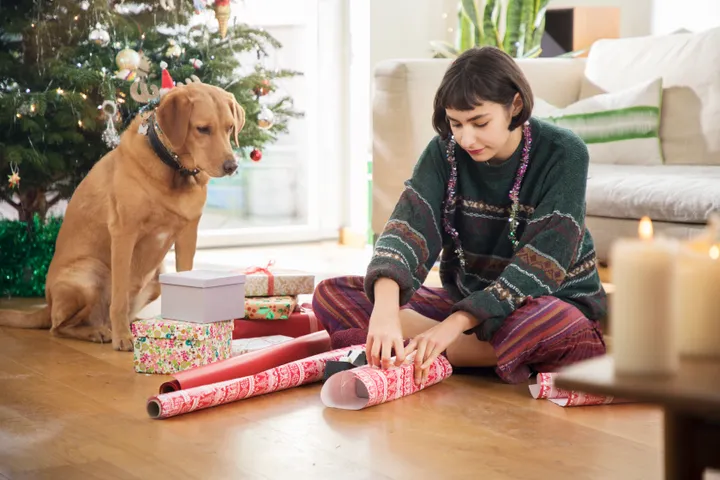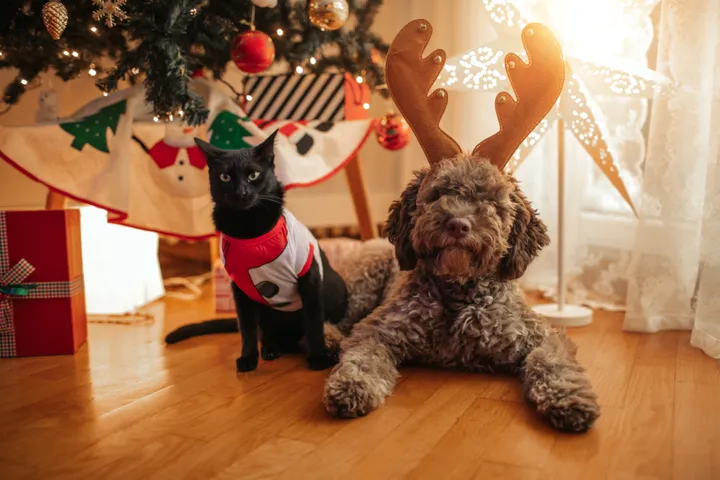Experts share what dog and cat owners should pay attention to during the festive season.
The holiday season is a magical time filled with decorations, festive meals, and gift-giving, but for pet owners, it also comes with unique challenges. According to Dr. Jamie Richardson, head of veterinary medicine at Small Door Veterinary, the winter holidays offer a wonderful chance to celebrate with loved ones, including pets, but also require heightened vigilance to avoid potential hazards.
Amid the celebrations, pets may encounter tempting but dangerous items, while owners might be distracted by the festivities. To ensure your furry friends stay safe, experts have identified key holiday-related risks and shared tips to keep pets out of harm’s way. Here are some important warnings and advice for pet-proofing your holidays:
- Holiday Foods: Many festive treats, like chocolate, onions, grapes, and certain spices, are toxic to pets. Avoid leaving food within reach, and educate guests about what pets shouldn’t eat.
- Decorations: Items like tinsel, ornaments, and string lights can pose choking or electrocution hazards if chewed or swallowed. Keep decorations out of reach or secure them properly.
- Plants: Popular holiday plants, such as poinsettias, mistletoe, and holly, can be toxic to pets. Opt for pet-safe alternatives or place these plants in areas pets can’t access.
- Candles and Fireplaces: Open flames and hot surfaces can cause burns. Use pet-safe barriers and never leave pets unsupervised near lit candles or fireplaces.
- Gift Wrap and Ribbons: Wrapping materials, especially ribbons and bows, can be irresistible but dangerous if ingested. Dispose of these items promptly after opening gifts.
- Holiday Stress: A bustling home filled with guests can overwhelm some pets. Create a quiet, safe space for them to retreat if needed.
By staying mindful of these risks and taking preventative measures, you can ensure a safe and joyful holiday season for every member of your household—four-legged ones included!
Christmas Trees
Holiday trees can be a festive centerpiece, but they come with risks for pets. Experts offer these tips to keep your furry friends safe while preserving the holiday spirit:
- Sweep or Vacuum Needles Regularly
Dr. Jamie Richardson warns that pine needles can harm pets if ingested and may irritate paw pads. Clean up fallen needles frequently to avoid these issues. - Secure Your Tree
For climbers or rambunctious pets, anchoring the tree to a wall or window can prevent it from toppling over. Wrapping the trunk in aluminum foil can deter cats, as they dislike its texture and sound. - Prevent Access to Tree Water
Tree water can harbor bacteria, leading to stomach upsets if consumed. Richardson recommends using a tight-fitting tree skirt or a covered stand to limit access. - Consider Barriers or Off-Limit Areas
Dr. Amber Karwacki suggests using baby gates to block access to the tree or placing it in a pet-free room. This adds an extra layer of safety. - Let Pets Investigate Safely
Allow pets to observe the tree before decorating. This can reduce curiosity-driven mischief. - Use Deterrents
Dr. Sarah Wooten recommends sprays with scents like citrus, bitter apple, or citronella to discourage pets from chewing or climbing. If your cat is persistent, avoid leaving them unsupervised near the tree. - Positive Reinforcement
Reward pets for good behavior around the tree and redirect them when they engage in unwanted actions like climbing or batting ornaments.
By implementing these strategies, you can enjoy your holiday tree without compromising your pet’s safety or your peace of mind!
Ornaments
Holiday ornaments add sparkle to your tree but can pose risks to pets. Here are expert tips to keep your decorations safe for furry family members:
- Avoid Easily Breakable Ornaments
Dr. Jamie Richardson advises against using fragile ornaments, as broken pieces can cut pets or cause internal injuries if swallowed. Cats, in particular, love knocking ornaments off trees, so it’s best to opt for shatterproof options. - Hang Breakable or Valuable Ornaments High
If you must use delicate or heirloom ornaments, place them on upper branches, out of reach of curious pets. - Secure Ornaments Properly
Dr. Kira Ramdas recommends firmly attaching ornaments to prevent them from falling, especially the heavier ones, which could injure pets if dislodged. Place sturdy decorations on lower branches for added stability. - Use Pet Deterrent Sprays
Dr. Danielle Bernal suggests spraying decorations with pet-safe deterrents, such as those with citrus or bitter scents, to discourage pets from chewing or swatting at them. - Keep Ornaments Made of Dangerous Materials Away
Ensure ornaments are free of parts that can be chewed or swallowed, like feathers or soft pieces that pets might mistake for toys. - Supervise and Monitor
Always keep an eye on your pets around the tree to quickly address any risky behavior. Consider redirecting them with their own holiday toys to satisfy their curiosity.
By following these precautions, you can enjoy a beautifully decorated tree without endangering your pets.
Electrical Cords And String Lights
Holiday lights and electrical decorations can create a festive atmosphere, but they can also pose risks to pets. Here are tips to keep your furry friends safe:
- Watch Out for Chewing Hazards
Erin Askeland highlights the danger of pets chewing on cords, which can lead to burns or electric shock. Unplug lights when you’re not at home and supervise your pets around electrical decorations. - Use Cord Protectors
Cable guards or securely taping down cords can make them less appealing and accessible, especially for curious puppies and kittens. - Adjust Light Placement
Keep tree lights higher up and closer to the trunk to discourage pets from playing with or chewing them. Avoid low-hanging strings of lights that are within easy reach. - Opt for Safer Alternatives
Dr. Danielle Bernal suggests using battery-powered lights and candles to reduce risks. Pair these with plastic ornaments to minimize hazards further. - Conceal Cables
Hide cords under rugs or tree skirts to keep them out of sight and out of reach. This also prevents accidental tripping. - Know the Signs of Electric Shock
Dr. Jacqueline Brister advises watching for symptoms such as drooling, reduced appetite, open-mouth posture, or red, blistered skin. If you suspect an injury, seek veterinary care immediately.
By taking these precautions, you can create a safe holiday environment for your pets while enjoying your festive décor.
Tinsel
Tinsel may add sparkle to your tree, but it poses a serious risk to pets, particularly cats. Here’s how to prevent accidents:
- Avoid Using Tinsel
Dr. Jamie Richardson warns that tinsel’s shininess can attract cats, leading them to chew or swallow it. If ingested, tinsel can cause severe intestinal damage or blockages, which may require emergency surgery. - Keep It Out of Reach
If you can’t part with tinsel, ensure it’s placed high on the tree where pets can’t access it. However, avoiding tinsel entirely is the safest option. - Watch for Symptoms of Blockage
Laura Watson emphasizes monitoring pets for signs of intestinal obstruction, such as:- Lethargy or excessive sleeping
- Hiding behavior
- Vomiting or refusing food
- Act Quickly if Tinsel Is Swallowed
If you suspect your pet has eaten tinsel, contact your veterinarian immediately. Prompt treatment is critical to avoid life-threatening complications.
By opting for safer decorations and staying vigilant, you can keep your pets safe while still enjoying a festive holiday tree.
Gift-Wrapping Materials
Holiday gift wrapping can be delightful, but it poses several risks to pets. Here’s how to ensure their safety during the festivities:
- Clean Up Immediately
Gift-wrapping materials like ribbons, bows, and strings should be put away as soon as you’re done. Dr. Jo Myers highlights that items like ribbons can cause severe gastrointestinal blockages in pets, especially cats. Their barbed tongues make it difficult for them to spit out strings, increasing the likelihood of accidental ingestion. - Store Gifts Securely
Dr. Amber Karwacki advises keeping wrapped gifts in a closet or another secure location until it’s time to open them. This prevents pets from chewing wrapping paper or ribbons, which can lead to stomach upset or obstructions. - Dispose of Wrapping Materials Responsibly
After opening gifts, immediately dispose of ribbons, bows, and other small packaging materials in a pet-proof bin. Leaving them around increases the risk of ingestion, particularly for curious animals. - Know the Symptoms of GI Obstruction
Watch for signs such as:- Vomiting or reduced appetite
- Lethargy
- Hiding behavior
If you suspect your pet has ingested a foreign object, contact a veterinarian immediately. Surgery is often required to remove these materials.
By staying proactive and mindful of wrapping materials, you can protect your pets from potentially life-threatening complications while enjoying the holiday season.

Plants and Decorations:
- Toxic Plants: Avoid mistletoe, holly, lilies, poinsettias, cedar, and pine. These can cause symptoms ranging from upset stomachs to fatal kidney damage (e.g., lilies for cats). Use artificial plants or place real ones out of reach.
- Tinsel and Ornaments: Tinsel can cause intestinal blockages if ingested, while ornaments can have sharp edges. Use non-breakable decorations and hang fragile items higher on the tree.
- Christmas Trees: Secure your tree to prevent toppling. Wrap the trunk in aluminum foil to deter climbing cats. Use tight-fitting skirts or covered stands for water to prevent pets from drinking it.
Gifts and Wrapping Materials:
- Wrapping Hazards: Ribbons, bows, and gift wrap can cause choking or intestinal blockages. Clean up promptly after unwrapping gifts.
- Toys: Keep children’s toys with magnets or small parts away from pets. Avoid giving rawhide or antlers to dogs as these are choking hazards.
Holiday Foods:
- Toxic Foods: Avoid chocolate, xylitol-sweetened treats, peppermint, raisins, garlic, onions, and turkey skin. These can cause symptoms from vomiting to life-threatening conditions.
- Safe Snacks: Sweet potatoes or baby carrots are pet-friendly options.
Candles and Essential Oils:
- Candles: Keep lit candles at least 12 inches away from flammable objects and out of reach. Extinguish them before leaving the room.
- Essential Oils: Avoid potpourri and oils like clove, eucalyptus, tea tree, peppermint, and pine, as they can cause symptoms ranging from mild irritation to severe organ damage.
Medications and Substances:
- Medications: Ensure all prescription and recreational drugs are locked up. Guest medications can be hazardous to pets. Symptoms of ingestion include dilated pupils, twitching, or aggression.
- Alcohol and Edibles: Keep these away from pets to avoid severe toxicosis.
General Precautions:
- Supervise and Confine: Keep pets in pet-safe areas when you’re unable to monitor them.
- Vet Contacts Ready: Have your veterinarian’s contact information and pet medical records on hand for emergencies.
By taking these precautions, you can ensure a festive and safe holiday season for your entire household, pets included!
